The weak banks must be merged by December. Bangladesh Bank has set a deadline for the weak banks to merge voluntarily by December next year. During this time, if these banks fail to merge voluntarily, Bangladesh Bank will decide to merge them from March of the following year based on the performance of the banks.
In this case, the interests of depositors will be protected, and international practices will be followed to facilitate the mergers.
The Executive Director and Spokesperson of Bangladesh Bank, Mejbauul Haque, disclosed this information at a press conference on Tuesday (March 12).
He stated that according to the policy, decisions will be made about those who are on the weak list by December next year. Following international discussions, the process and criteria for bank mergers will be adopted, and guidelines will be issued accordingly.
Regarding the banks that will be merged, their health will be assessed by reputable audit firms. Only after that will the merger process begin. When banks merge, it will be in a proper and transparent process. Both the strengths and weaknesses of the banks will be considered.
According to recent reports in the media, the following banks are in good condition: Prime Bank, Eastern Bank, NCC Bank, Midland Bank, Bank Asia, Southeast Bank, Jamuna Bank, Shahjalal Islami Bank, Bank Alfalah, UCB, HSBC, Commercial Bank of Ceylon, City Bank NA, Habib Bank, Standard Chartered Bank, and State Bank of India.
Among the 29 banks in the Yellow Zone, 26 are in good condition. The banks in the Yellow Zone are IFIC Bank, Meghna Bank, Social Islami Bank, Islami Bank, One Bank, United Commercial Bank, NRB Bank, Al-Arafah Islami Bank, Standard Bank, Union Bank, NRB Commercial, Mercantile Bank, Mutual Trust Bank, Exim Bank, Dutch-Bangla Bank, Global Bank, Premier Bank, BRAC Bank, Southeast Bank, City Bank, Trust Bank, South Bangla, Madhumati, Dhaka Bank, Uttara Bank, and Pubali Bank.
The banks in the Red Zone are Bangladesh Commerce Bank, Padma Bank, Basic Bank, National Bank of Pakistan, National Bank, Janata Bank, Agrani Bank, Rupali Bank, and AB Bank.
Although three banks are in the Yellow Zone, they are situated close to the Red Zone. These are Bangladesh Development Bank (BDBL), Sonali Bank, and First Security Islami Bank.
At the beginning of next month, the Governor of the Central Bank, Abdur Rouf Talukdar, met with the leadership of the Bangladesh Association of Banks (BAB). At that time, he informed them of the plan to merge at least 10 banks by January of the following year to reduce non-performing loans and ensure proper governance in the banking sector.

